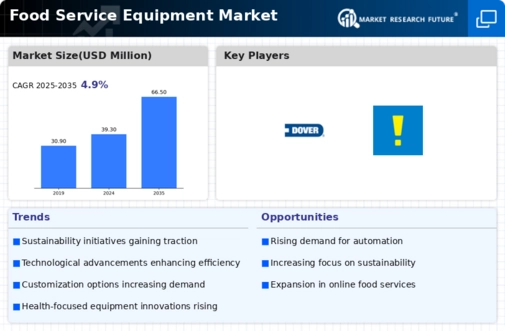Top Industry Leaders in the Food Service Equipment Market

Competitive Dynamics in the Food Service Equipment Market A Glimpse into the Fray
The global Food Service Equipment Market stands as a dynamic and burgeoning domain where assorted entities vie for a portion of the lucrative landscape. Comprehending the intricate competitive dynamics is pivotal for navigating this sphere and making judicious decisions. Let's plunge into the strategies, trends, and factors molding this battleground.
Key Contenders and Tactics:
- Meiko (Germany)
- Duke Manufacturing Co. Inc. (US)
- Hoshizaki Electric Co. Ltd (Japan)
- Fujimak Corporation (Japan)
- Tupperware Hobart Corporation (US)
- Dover Corporation (US)
- Brands Corporation (US)
- Electrolux AB (Sweden)
- Ali Group Spa (Italy)
- Manitowoc Company Inc., and others.
This market showcases stalwart behemoths like Electrolux, Ali Group (Markeit), Dover Corp., and Middleby, interspersed with local players and emerging innovators. These entities deploy diverse strategies:
-
Dominant Players: Giants leverage their extensive product portfolios, established distribution networks, and brand recognition to uphold commanding positions. Heavy investments in Research and Development, with a focus on automation, energy efficiency, and connectivity solutions, exemplify this expansionary approach. Electrolux's acquisition of Welbilt is a testament to such strategic augmentation.
-
Regional Operatives: These entities capitalize on their profound understanding of local needs and preferences, delivering cost-effective apparatus tailored to regional cuisines and regulations. Markeit's success in Europe, achieved through acquisitions and product adaptations, elucidates this strategy.
-
Specialized Entrants: Niche players concentrate on specific apparatus categories or innovative technologies, aiming to distinguish themselves through superior performance, avant-garde features, or sustainability measures. Ecolab's emphasis on sanitation and hygiene solutions serves as a prime exemplar.
Determinants for Market Share Analysis:
Beyond mere brand nomenclature, numerous factors orchestrate the dynamics of market share:
-
Diverse Product Array: Providing an assorted range of apparatus catering to various segments such as restaurants, cafes, and hotels, spanning diverse cuisines, broadens reach and customer appeal. Middleby's varied portfolio, encompassing various cooking technologies like convection, grills, and fryers, stands as a formidable example.
-
Price-Quality Equilibrium: Striking a harmonious balance between competitive pricing and robust quality is imperative. Entities like Dover Corp. achieve this equilibrium through modular apparatus designs and streamlined manufacturing processes.
-
Efficient Distribution Network: Streamlined distribution channels and post-sales service are vital for punctual deliveries and maintenance of apparatus. The extensive global network of Ali Group accentuates the criticality of this factor.
-
Technological Prowess and Ingenuity: Pioneering the adoption of automation, integration of Artificial Intelligence, and data-driven solutions for kitchen management provides entities with a distinctive competitive edge. Manitowoc's recent introduction of connected cooking apparatus underscores this prevailing trend.
Novel and Emerging Trends:
The terrain is in a perpetual state of flux, propelled by emergent trends:
-
Sustainability: Energy-efficient apparatus, employment of eco-friendly materials, and solutions for waste reduction are gaining considerable traction. Entities like Welbilt are seamlessly integrating these eco-conscious facets into their product lines.
-
Personalization and Customization: Apparatus tailored to specific culinary requirements and consumer preferences are increasingly coveted. Modular designs and bespoke configurations cater to this burgeoning trend.
-
Cloud-Centric Kitchen Management: Real-time data analytics and remote monitoring of apparatus optimize kitchen operations and augment efficiency. Platforms such as Zumex's Smart Kitchen proffer solutions aligned with this paradigm.
-
Delivery and Ghost Kitchens: The ascendancy of food delivery and virtual kitchens necessitates compact, high-performance apparatus. Manufacturers are adapting their offerings to meet the demands of this burgeoning sector.
Overall Scenario of Competitiveness:
The culinary apparatus market stands as a fiercely competitive yet collaborative arena. Collaborations, mergers, and acquisitions abound, as entities endeavor to extend their reach and gain access to new technologies. The fostering of open platforms and interoperability among apparatus is also gaining prominence, nurturing collaboration within the ecosystem.
Entities that adeptly acclimate to emerging trends, invest in pioneering research and development, and furnish robust solutions tailored to specific segments are poised to relish the sweet taste of success in this dynamic market.
Industry Advancements and Recent Updates:
Meiko (Germany)
-
Date: December 15, 2023 -
Development: Meiko collaborates with ReFED, a company dedicated to reducing food waste, to champion sustainable practices in the food service industry. (Source: Waste Management World)
Duke Manufacturing Co. Inc. (US)
-
Date: December 19, 2023 -
Development: Duke Manufacturing announces the expansion of its production facility in Missouri to meet the escalating demand for pizza ovens. (Source: Pizza Magazine)
Hoshizaki Electric Co. Ltd (Japan)
-
Date: December 12, 2023 -
Development: Hoshizaki partners with Winnow, an AI-powered company specializing in food waste prevention, to develop intelligent ice machines that mitigate product spoilage. (Source: Food Engineering Magazine)
Fujimak Corporation (Japan)
-
Date: December 7, 2023 -
Development: Fujimak acquires a majority stake in the US-based commercial refrigeration company True Refrigeration Equipment Corporation. (Source: Supermarket News)

